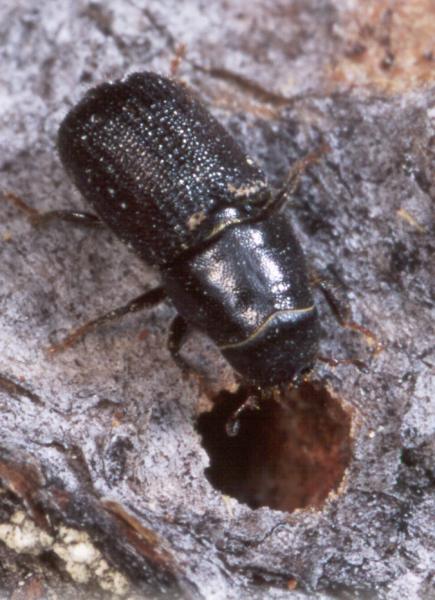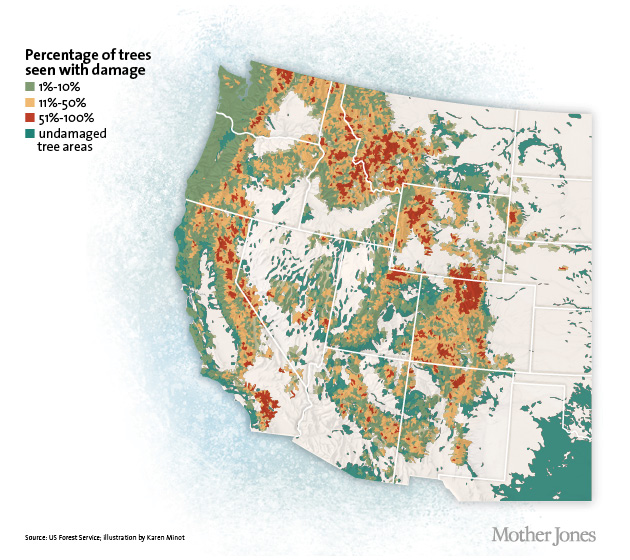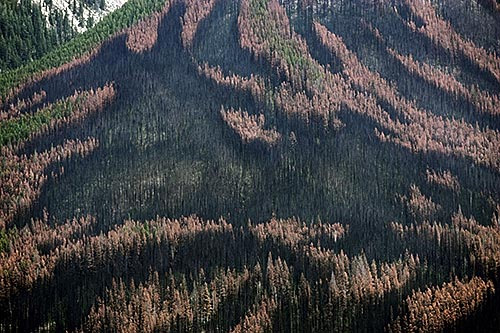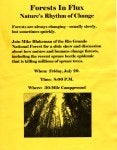For those uninitiated here's a couple pictures, one of a beetle and one of the kind of destruction they can wreak on the forests.
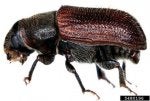
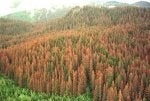
Yesterday I had to change my plans regarding where I wanted to fish because of the Spruce Bark Beetle. Not actually due to a swarm of beetles but because of the standing dead spruce trees that predominate the landscape here in Southcentral Alaska. I know there are other Alaskans who belong to the forum and was wondering if you have this in your parts of the state.
I'm a creature of habit and even more so when it comes to fishing so yesterday morning I launched the boat and headed for a spot 16 miles upriver where I lost a very large fish 5 years ago. I know that given the size of this rainbow / steelhead trout it in all likelihood dead by now but habits are hard to break.
I return to that run every fall at least once and usually several times just to see if another has taken up the post held by that giant so long ago. When I say Giant I mean a trout that will exceed 30 inches and also one that will weigh at least 12 pounds, that's a big one. I've caught big ones but I either get long fish that are skinny or shorter fish that are bordering on the obese...... The fish I saw that day in the past, the fish that just simply came unhooked, that fish may have had it all. It was big.
So away we went, Boss and I, headed off on a fairly long ride. I try to keep the speed at or under 18 mph so that as I pass areas where there are a lot of spawning silvers I can look for the target species. That target being large trout, they can be seen because the silvers have now turned and are basically red fish. They aren't hard to spot, a bunch of 6 to 13 pound fish between 24 and 36 inches long that are red..... Yep, pretty easy to spot and when you see a group you are looking not at the red ones but for something moving just downstream of them that isn't red. It may just seem to be an anomaly, you may not get a good look but if you think you saw something, you probably did.
Generally once you have driven a jet boat through the area close enough to think you've seen something you have also sent that something running for dear life and stopping to fish probably won't pay off. So you look for landmarks, you make a mental note to self of where that something you think you saw was at. The idea here is that after you reach your destination and finish fishing there you come downstream drifting not running un step. If you do a good job of picking your landmarks you will know when you're about 100 yards above your special something that you think you saw..... Sounds like a lot of work doesn't it?
Getting back to the original storyline, as I was driving along at about mile 13.5 (I have a Garmin mounted on my console) I passed a massive dead spruce tilted out over the river looking every bit as if it could finish its plunge onto the river as I passed under but I passed anyway. Not more than half a mile farther I came onto one on the left side that was in the same condition but with a caveat. Caveat being that the trunk was split wide open so that I could see right through the thing! I passed but slowed, within another 100 yards I was at an idle and static in the flow checking depth for a 180* turn.
I could not go on. We all see trees that have fallen. We've all heard the old puzzle, "If a tree falls in the forest and no one is there does it still make noise"? I could not bet that neither would fall while I was fishing 3 miles upstream of them so I turned back.
If you have your chainsaw and plenty of gas with you, then you could go on but I did not. If the river were blocked you would have to be able to drive the boat another 40 miles to reach a take out point and your truck and trailer would not be there and that's if there were no more trees down upstream. We had some serious wind and hail just yesterday the day before I went, and all bets were off on what was upriver...……
I drifted and stopped many times coming down the river, caught a few salmon by accident but no trout, no steelhead. Maybe the extra water, maybe the silt washed in from the hard rains, maybe the tremendous number of leaves drifting in every section of the water column...… Who knows but I caught no trout.
Still it was beautiful out there albeit a little more breezy / windy than is conducive to casting well but I managed to get the fly in the water enough that my hopes were sinking by 5:30 PM and by 6:30 I had fired up the engine and hit the throttle. The good news was that the extra water allowed for an easy trip back and running with the current I can hit 35 mph and was back at the launch in 2 flicks of a lambs tail
I'll rest it a few days and let the water drop and clear again. I really believe that if that water is clouded the fish don't even see the fly and you are just practice casting and honing your technique.
Ard


Yesterday I had to change my plans regarding where I wanted to fish because of the Spruce Bark Beetle. Not actually due to a swarm of beetles but because of the standing dead spruce trees that predominate the landscape here in Southcentral Alaska. I know there are other Alaskans who belong to the forum and was wondering if you have this in your parts of the state.
I'm a creature of habit and even more so when it comes to fishing so yesterday morning I launched the boat and headed for a spot 16 miles upriver where I lost a very large fish 5 years ago. I know that given the size of this rainbow / steelhead trout it in all likelihood dead by now but habits are hard to break.
I return to that run every fall at least once and usually several times just to see if another has taken up the post held by that giant so long ago. When I say Giant I mean a trout that will exceed 30 inches and also one that will weigh at least 12 pounds, that's a big one. I've caught big ones but I either get long fish that are skinny or shorter fish that are bordering on the obese...... The fish I saw that day in the past, the fish that just simply came unhooked, that fish may have had it all. It was big.
So away we went, Boss and I, headed off on a fairly long ride. I try to keep the speed at or under 18 mph so that as I pass areas where there are a lot of spawning silvers I can look for the target species. That target being large trout, they can be seen because the silvers have now turned and are basically red fish. They aren't hard to spot, a bunch of 6 to 13 pound fish between 24 and 36 inches long that are red..... Yep, pretty easy to spot and when you see a group you are looking not at the red ones but for something moving just downstream of them that isn't red. It may just seem to be an anomaly, you may not get a good look but if you think you saw something, you probably did.
Generally once you have driven a jet boat through the area close enough to think you've seen something you have also sent that something running for dear life and stopping to fish probably won't pay off. So you look for landmarks, you make a mental note to self of where that something you think you saw was at. The idea here is that after you reach your destination and finish fishing there you come downstream drifting not running un step. If you do a good job of picking your landmarks you will know when you're about 100 yards above your special something that you think you saw..... Sounds like a lot of work doesn't it?
Getting back to the original storyline, as I was driving along at about mile 13.5 (I have a Garmin mounted on my console) I passed a massive dead spruce tilted out over the river looking every bit as if it could finish its plunge onto the river as I passed under but I passed anyway. Not more than half a mile farther I came onto one on the left side that was in the same condition but with a caveat. Caveat being that the trunk was split wide open so that I could see right through the thing! I passed but slowed, within another 100 yards I was at an idle and static in the flow checking depth for a 180* turn.
I could not go on. We all see trees that have fallen. We've all heard the old puzzle, "If a tree falls in the forest and no one is there does it still make noise"? I could not bet that neither would fall while I was fishing 3 miles upstream of them so I turned back.
If you have your chainsaw and plenty of gas with you, then you could go on but I did not. If the river were blocked you would have to be able to drive the boat another 40 miles to reach a take out point and your truck and trailer would not be there and that's if there were no more trees down upstream. We had some serious wind and hail just yesterday the day before I went, and all bets were off on what was upriver...……
I drifted and stopped many times coming down the river, caught a few salmon by accident but no trout, no steelhead. Maybe the extra water, maybe the silt washed in from the hard rains, maybe the tremendous number of leaves drifting in every section of the water column...… Who knows but I caught no trout.
Still it was beautiful out there albeit a little more breezy / windy than is conducive to casting well but I managed to get the fly in the water enough that my hopes were sinking by 5:30 PM and by 6:30 I had fired up the engine and hit the throttle. The good news was that the extra water allowed for an easy trip back and running with the current I can hit 35 mph and was back at the launch in 2 flicks of a lambs tail
I'll rest it a few days and let the water drop and clear again. I really believe that if that water is clouded the fish don't even see the fly and you are just practice casting and honing your technique.
Ard
Last edited:

